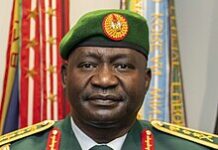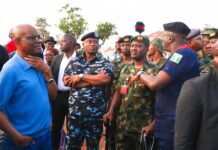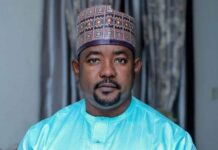ARTIST FACES JAIL AFTER STARTING FIRE AT SECURITY HQ
One of Russia’s most radical political performance artists faces up to three years in jail after setting fire to the main entrance to the headquarters of the FSB security service, the successor to the Soviet-era KGB secret police. Police detained Pyotr Pavlensky after he doused the main entrance of the building – a symbol of Communist-era repression and state authority for many Russians – with petrol and started a fire. Footage posted on a video-sharing website from Pavlensky’s account showed him standing on Moscow’s Lubyanka Square in front of the vast, yellow-brick, neo-baroque FSB building holding a petrol can as the fire raged behind him. It also showed the 31-year-old being detained by police, who later said they had opened a criminal case against him for suspected vandalism, a charge that carries a jail term of up to three years.
In a message accompanying the video, Pavlensky called his performance “The Threat”, saying it was meant to draw attention to what he called the terror tactics used by the FSB, which was briefly run by Vladimir Putin before he became president. “Fear turns free people into a sticky mass of uncoordinated bodies,” he said. “The threat of inevitable reprisal hangs over everyone who can be tracked with devices, have their conversations listened to, or at borders with passport checks.” Pavlensky has carried out extreme acts before, which he says are designed to poke holes in the Kremlin’s propaganda machine. In 2012, he sewed his lips together to protest against the jailing of anti-Kremlin punk band Pussy Riot, and the following year he wrapped himself in barbed wire to express his opposition to laws he deemed regressive. In November 2013, he nailed his scrotum to Moscow’s Red Square, a gesture he described as a metaphor for the political apathy of Russian society. He was briefly detained in October 2014 after slicing off part of his earlobe while sitting naked on the roof of an infamous state psychiatry clinic to protest against what he said was the Kremlin using psychiatric hospitals for political ends. Doctors have declared Pavlensky, who has in the past been ordered to undergo psychiatric tests, sane. But veteran human rights activist Lyudmila Alexeyeva, told the Interfax agency after condemning his latest actions, that he should be checked again. Public reaction to his latest act was mixed with some Russians taking to social media to laud his bravery and others strongly denouncing him. (Pulse.ng)
NIGERIANS TROOPS FREE HUNDREDS IN RAID ON BOKO HARAM CAMPS, ARMY SAYS
Nigerian troops rescued 338 people held captive at suspected Boko Haram terrorist camps, the Nigerian army said in a statement. At least 30 Boko Haram terrorists were killed during the operation, which freed 192 children, 138 women and eight men. The army said it recovered arms and ammunition during the raid. The camps were located in the Bulajilin and Manawashe villages on the edge of Sambisa Forest. The government gave no indication whether any of those rescued were among the hundreds of girls kidnapped in Chibok, Nigeria, in April 2014, who inspired the “Bring Back Our Girls” campaign. The group has robbed banks, kidnapped many people, including children, and attacked police stations. Also recently, Nigerian troops, acting on a tip, ambushed and killed four suspected Boko Haram terrorists allegedly on a suicide bombing mission to Adamawa state. Those soldiers recovered two AK-47 rifles, some unexploded bombs, mortar devices and cash, according to the army statement. “We shall continue to decisively deal with Boko Haram terrorists until they are defeated,” it read, asking that residents cooperate with the military and security agencies. This wasn’t the first successful operation the Nigerians have conducted against Boko Haram that freed hostages. In September the Nigerian military rescued 241women and children in a raid on two camps controlled by Boko Haram, the military reported. That mission unfolded in the villages of Jangurori and Bulatori. Forty-three militants who belonged to the terrorist group were arrested, the military said, including a senior leader in the organization. (CNN.com)
FORMER ISRAELI PRESIDENT DIES AT 94; BRIDGED CULTURAL GAPS
Yitzhak Navon, Israel’s fifth President and its first President born in Jerusalem, died recently at age 94, Israel’s foreign ministry said. Navon became the first Israeli President to visit an Arab state, when he travelled to Egypt in October 1980. He was given a warm reception by then Egyptian President Anwar Sadat, who had signed the Egypt-Israeli Peace Treaty months before. Navon was known for his work to bridge ethnic gaps, including relations between religious and secular Jews and between Jews and Arabs, according to the Israeli presidency’s website. He served under Prime Minister Menachem Begin from 1978-1983. Before his presidency, Navon worked with David Ben-Gurion, Israel’s first Prime Minister. He was elected to the Knesset in 1965 and served there until his presidency. After serving as President, Navon returned to politics in 1984, winning a seat with the centre-left Alignment party. He became the Deputy Speaker of the Knesset and served on the Foreign Affairs and Defence Committee. He left politics in 1992.
SIERRA LEONE IS FINALLY EBOLA FREE
Sierra Leone is Ebola-free. Emergency measures have ended, and the country erupted into celebrations at last, with people gathering en masse in the streets of Freetown for the first time in almost 18 months. The country marked ‘0+42’ — 42 days without a new case of the disease in November, the threshold at which the World Health Organization declares the outbreak over. There will now be a further 90 days of ‘enhanced surveillance’ before the response fully draws down, and the government can throw its resources behind rebuilding a battered economy. “It’s good news, yes, but there’s a lot of work to come after it,” says John Sisay, the CEO of Sierra Rutile, which exports mineral sands from the country. The epidemic killed more than 11,000 people across West Africa 4,800 in Sierra Leone, and devastated the social sectors in countries that were already among the poorest in the world. Schools and other public services closed, markets shut down as people avoided congregating. With insurance premiums for international businesses skyrocketing, ships did not dock, investors cancelled trips and the nascent tourism industry all but shut down. The outbreak came at a point when the region was already struggling with a downturn in commodity prices, which had put the brakes on economic growth. The price of iron ore, the principal export of Sierra Leone, Guinea and Liberia, has collapsed, falling from $136 per tonne in January 2014 to around $56 per tonne today, leaving all three countries without one of their major sources of hard currency. African Minerals, one of Sierra Leone’s largest investors in iron ore, went into administration in March, having shuttered its Tonkolili mine the previous November. It followed London Mining, which closed its operations in the country in October 2014.
WORLD’S MOST EXPENSIVE DIAMOND SELLS FOR $48.4M
It weighs a hefty 12.03 carats. The colour? An exceptionally fancy vivid blue. Recently, the ‘Blue Moon’ diamond sold for a whopping $48.4 million, making it the world’s most expensive diamond. According to the auctioneer David Bennett, it is the “highest price per carat” ever obtained for any kind of stone. The record sale, which took place at a Sotheby’s auction in Geneva, was a headline in itself. But when the successful bidder renamed it, ‘Blue Moon of Josephine’, tongues were set wagging. Just a day before, at a Christie’s auction, also in Geneva, an anonymous bidder purchased a 16.08-carat pink diamond, for $28.5 million. He dubbed it, ‘Sweet Josephine.’ At first, the auction houses only disclosed that it had gone to a “Hong Kong buyer,” but the names of the diamonds provided clues as to the purchaser’s true identity. CNN confirmed billionaire Joseph Lau, of property firm Chinese Estates Holdings, as the gem’s new owner. “Yes, the diamonds were bought by Mr. Joseph Lau for his daughter,” his assistant told CNN over the phone.
SCIENTISTS DISCOVER WHAT MAKES SHERPAS SUPERHUMAN
Mount Everest is the ultimate test for adventurers trying to test their boundaries, but when it comes to climbing this natural monument, one group of people excel — Sherpas. The Sherpa people are an ethnic group from Nepal who have lived in the high altitudes of the Himalayas for generations. They have long served as guides and porters, whose local expertise has been invaluable for foreigners attempting climbs in the area. But while they are admired for the ease with which they deal with the physical challenges of scaling some of the world’s biggest peaks, the biological reasons for their mountain-climbing prowess have remained unknown, until now. Denny Levett is a founding member of Extreme Everest and a consultant in clinical care at University Hospital Southampton, England. In 2013 she took part in Extreme Everest 2, a scientific expedition to the top of Everest, which explored the biology behind human endurance at high altitude. She still recalls the exploits of one particular Sherpa who was part of the expedition. (CNN.com)













